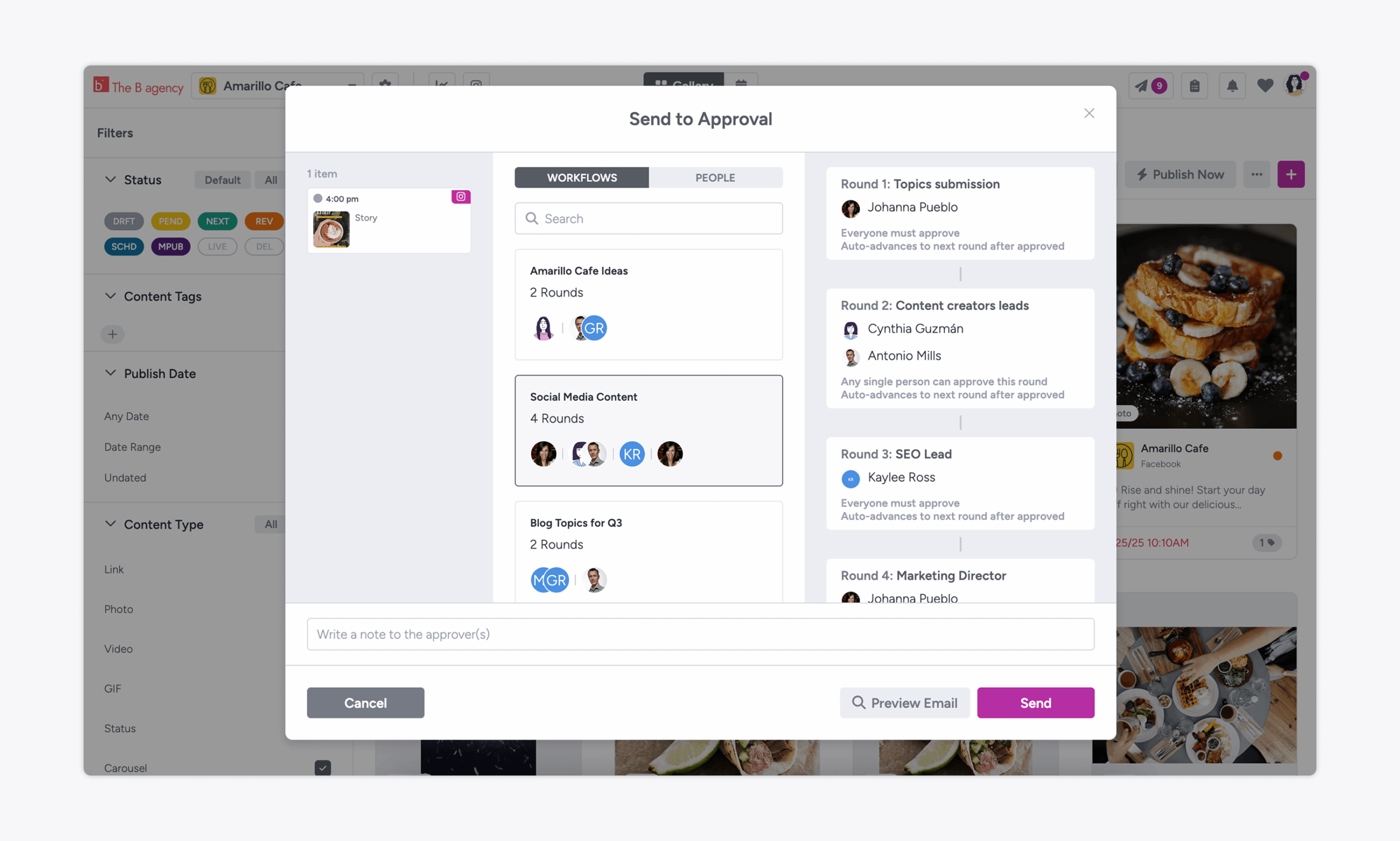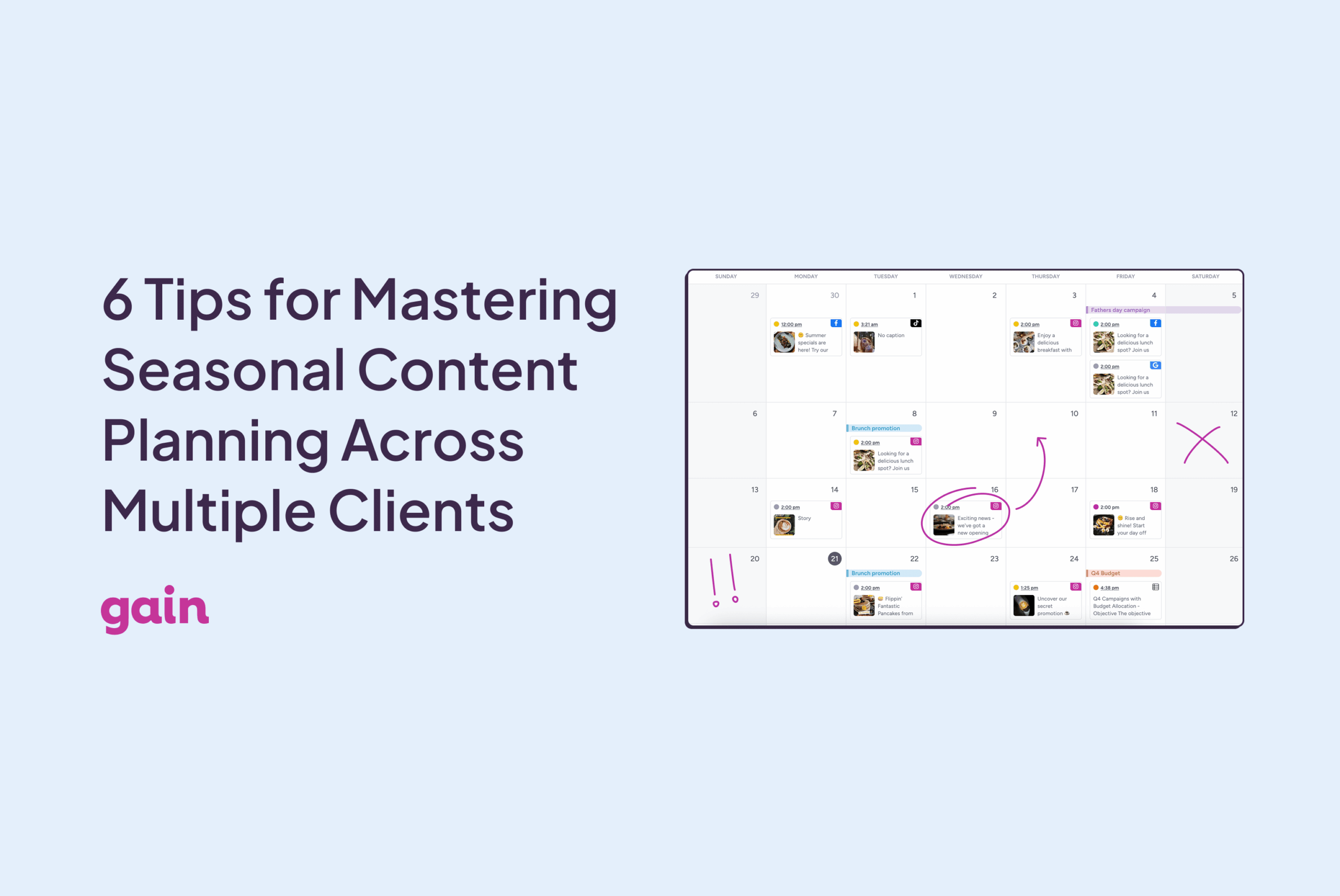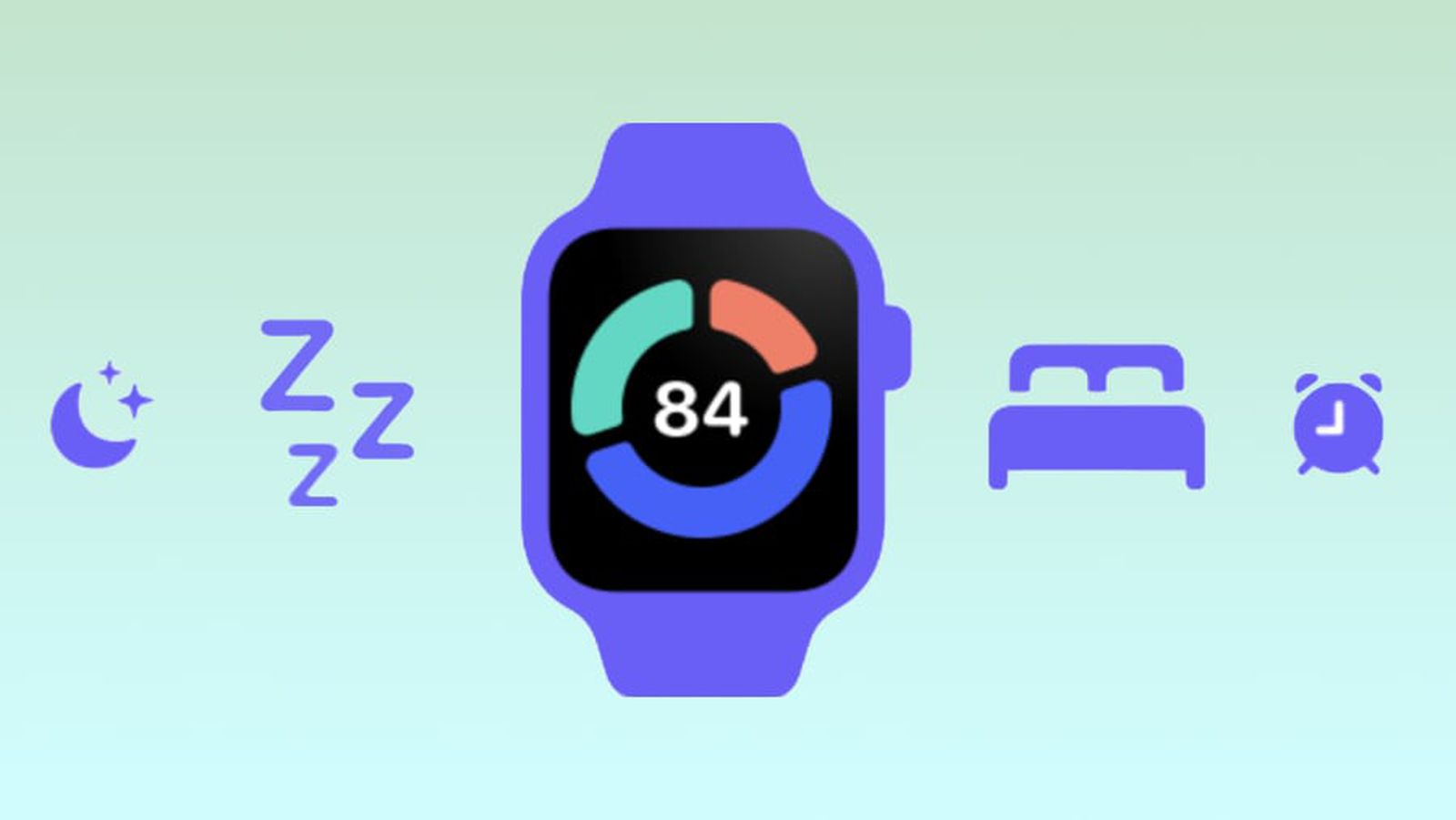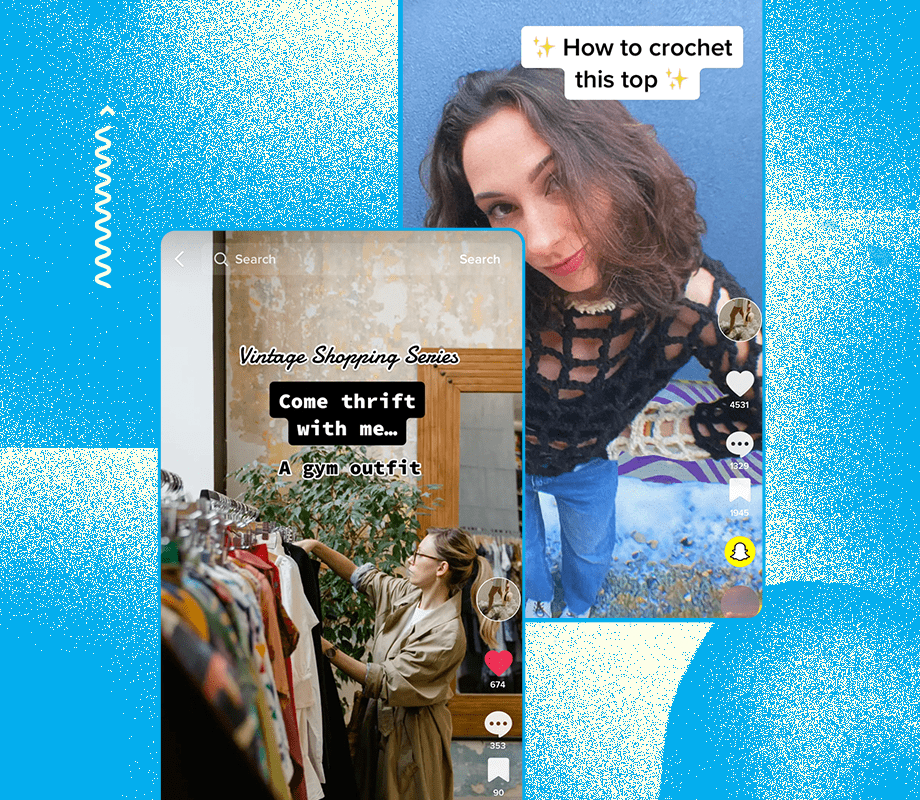Struggling to manage seasonal campaigns across clients? Discover 6 practical tips to simplify your content planning process year-round.
As a marketing agency, growing your client list is a good thing. As you succeed with this, however, a new challenge begins. Juggling various clients and their individual needs requires skill, careful planning, and hyper-organization.
Seasonal content planning can be particularly tricky to manage. Each client has their own pressing priorities, like product drops, event tie-ins, and sales pushes. Sometimes they all happen at the same time. For agencies, this can lead to a scheduling nightmare. That’s why we’ve compiled a cheat sheet to help you master your seasonal content planning for multiple clients.
What Is Seasonal Content Planning?
Seasonal content planning involves adjusting your client’s content strategy to align with the seasonal and social media climate. You can’t just keep posting like Black Friday doesn’t exist or as if Christmas isn’t on the horizon. Seasonal content planning helps you leverage existing trends and maximizes your client’s reach.
To make the most of the changing seasons and major annual events, you need to plan content that reflects the reality of your clients’ target market. This will help your clients stay relevant and boost engagement by piggybacking off events that already exist.
Core Challenges When Planning for Multiple Brands
Before we dive deep into solutions, it’s important to identify the challenges you’re facing. What are the pain points when managing multiple brands? What pitfalls can you avoid?
- Conflicting timelines and overlapping campaigns: The bottom line is that the more clients you have, the more clashes will occur. You have to manage campaigns carefully. Each client needs to feel like they are receiving appropriate attention and that their content is fresh and original.
- Platform management and scheduling: Not only do you have multiple brands to manage, each brand needs to post on multiple social media sites. This is a lot to keep track of. Poor platform management and a lack of a scheduling system can lead to mistakes and missed deadlines.
- Resource strain during peak seasons: Most companies want to amp up during peak seasons. These are typically annual holidays or significant cultural events, such as Easter or Christmas. Maybe you’ll get lucky and have clients with different focus areas. Maybe you’ll have clients that operate in the same sector and therefore have the same key times of year. This can lead to resource strain. Beware of team burnout and blowing the budget.
- Cultural or regional adaptation: If your client operates nationwide or internationally, you need to tailor your seasonal content appropriately. Be aware that your wintertime post on cold-weather accessories might be more relevant in Connecticut than Florida. This may involve more work, but it shows a deeper understanding of the target audience. Sometimes, universal appeal is your friend, but a smarter, more exact focus can pay dividends.
6 Tips to Master Seasonal Planning Across Clients
1. Build a Master Calendar First
Centralize all key dates. Add all product launches, holidays, and industry events as soon as you know about them. Make sure edits are traceable so you know who added what when. Accountability is key, so the calendar doesn’t get messy.
Remember earlier when we said you need to be hyper-organized? This is the first step. Once you have the master calendar perfected, you can build a personalized visual content calendar for each client.
2. Color-Code and Categorize by Brand & Theme
To avoid confusion between your clients, we recommend color-coding. Color-coding allows you to take a glance at your calendar and register what’s coming up in seconds. This helps to delineate the brands you work for, but also themes and seasonal changes. Try to keep it simple and ensure all your team members understand the color-coding system.
3. Start Earlier Than You Think
In this business, you can never really start thinking too far ahead. Although it’s good to stay agile so you can plug in the latest social media trends where needed, you should always keep one eye focused on the future.
Some seasonal events are predictable as they happen at the same time every year. Use this knowledge to schedule strategy meetings with clients far in advance. Keep the dialogue open. Encourage clients to share their product and campaign timelines with you as soon as they have them.
Starting earlier gives you more time to develop content, work through any tweaks with clients, and secure content reviews, timely approvals, etc.
4. Share Trend Inspiration Across Brands
Every client wants to feel like your only client, but having multiple clients is actually helpful. Having a finger in a variety of pies can help you sense the seismic shifts in different corners of the internet.
Sharing your trend inspiration across brands can give everyone a boost. You want everyone to benefit from your expertise, so don’t be afraid to spread it around.
5. Use Approval Tools With Client Access
The approval step of the content chain can be very costly, time-wise. When your content is seasonal, you can’t afford to miss the window. It can also become disorganized pretty quickly. If you’re scrolling through email threads looking for the latest sign-off, you’ve lost control.
That’s why we recommend using an approval tool that automates the process of gathering feedback for you. With Gain, our approval feature moves your content along the approval chain automatically after each stakeholder has signed off.

What’s more, you can build an approval workflow with the relevant agency staff and client-side decision-makers. It’s fully customizable with role-specific permissions. Clients can preview content in personalized, private approval queues and add annotations.
Automating your approvals means you know whether everyone is happy or not, and quickly. Plus, your team can free up time from following up on clients and bre more productive.
6. Conduct a Seasonal Post-Mortem
Our final tip for mastering season content planning involves some reflection. Once spring or summer is over, you know they’re going to come around again next year. Use your experience to improve your performance in the future. Analyze what worked, what didn’t, per brand.
Conduct your seasonal post-mortem by reviewing all your performance and engagement metrics for each client. Keep track of important social media KPIs. Compare client performance with each other so you get a more detailed overview instead of lumping them all together.
If a client has high-performing content, you can recycle it for the next season. You could do this for the same client or borrow the winning formula for a different client who didn’t do so well. Let the data drive you so that each time you need seasonal content, you’re more and more prepared. Keep your arsenal stocked with your best social media weapons.
FAQs
Ideally, start planning seasonal content 2–3 months in advance—longer for major holidays or campaign-heavy seasons. This gives your team time for strategy, production, and iteration without the last-minute scramble. Bonus: the earlier you plan, the more you can get client buy-in, secure ad placements, and coordinate across channels.
Yes—with caution. You can absolutely reuse content formats, winning concepts, or design templates, especially if they’ve proven successful. Just make sure each piece is tailored to the voice, audience, and goals of the brand you’re applying it to.
Use a dedicated content approval tool that keeps the process centralized, trackable, and transparent. Tools like Gain allow you to set up client-specific workflows, role-based permissions, and automated hand-offs. This eliminates long email chains and version confusion.
To Sum Up
Mastering seasonal content planning across multiple clients is a balancing act. You need to manage conflicting timelines and unique needs, but keep your service even across the board. You must be prepared and plan as much as you can, but don’t become rigid. With trend cycles moving faster and faster, agility is key.
Staying organized and future-focused will get you only so far; even the best strategies can fall short without the right tools. If you want to simplify approvals and organize your content with ease, it’s time to try Gain. Our social media management platform is built for agencies juggling multiple clients.
Gain offers customizable content approval workflows, shared calendars, and a client-friendly interface that make client-agency communication a breeze. Don’t believe us? Start your free trial today to take the chaos out of seasonal planning.











